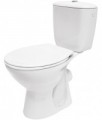Drain (to the sewer)
The design of the outlet pipe of the toilet bowl. It determines, in particular, the features of its installation. To date, there are such options:
—
Horizontal. In such toilets, the outlet pipe is located at the back of the bowl and is oriented horizontally backwards. This is one of the most common types in Europe and the post-Soviet space - it is due to the fact that sewer pipes in these countries are drawn along the floors, and the pipe in the bathroom is usually located under the wall, behind the toilet.
—
Oblique. In fact - a kind of horizontal release (see above), in which the outlet pipe is not strictly horizontal, but at an angle (usually 30° or 45°). It will be useful in the case that the sewer pipe is low, near the floor.
—
Vertical. As the name suggests, in these toilets the output is directed vertically down. They are mainly used in the United States and other American countries, where in the construction of communications, e.g. sewerage, conducted under the floor (ceiling) without taking into account the partitions - as a result, the toilet can be placed directly above the pipe. This layout is also found in the post-Soviet space, in particular in office and production premises, as well as in residential buildings on individual projects.
—
Universal. The universal release design allows it
...to be connected to one of the three above options, depending on the specific need. Most often, the output of such toilets is hidden inside, and its own nozzle is absent; for connection selected separate pipe of the desired shape, it can go vertically, horizontally or at an angle.
It should be noted that it is theoretically possible to install a toilet with horizontal release in the bathroom under the vertical, and vice versa - but in practice, this is very difficult and actually requires the reconstruction of the toilet. And therefore, before choosing a toilet, you must clarify the design of sewer pipes in your bathroom and the most suitable type of outlet.Bowl shape
The overall shape of the toilet bowl.
The choice of this parameter largely depends on the aesthetic preferences of the user and the overall design of the bathroom; however, the shape of the bowl is quite practical. So, in our time, the most common is
semicircular models, where the rear edge of the bowl is made straight, and the rest - rounded (oval, egg-like, etc.). This shape not only looks good - it is convenient to sit on, and the absence of angles (at least in front of the bowl) facilitates cleaning and reduces the risk of hitting the toilet with your foot. In addition, material on such a bowl requires less than a rectangular product of similar dimensions - as a result, semi-circular toilet bowls are relatively inexpensive and light.
The rectangular shape, in turn, gives a larger support area, which is important for users of large physique. However, toilet bowls
classical rectangular shape are rare (due to the high cost of production, as well as for some other reasons). Much more common are variations on this topic - the bowls
, with bevelled (rounded) corners, as well as
, with the front end shaped arc.
Water supply
Location of the pipe for supplying water to the toilet bowl. Modern toilets contain
lateral,
rear and
bottom water supply. In the first two types of pipes are located at the top of the tank, and the choice between side and rear supply in practice depends mainly on the location of pipes in the head and, accordingly, the convenience of connection. The bottom line is considered the most modern option: it provides a minimum level of noise when filling the tank, in addition to being easy to conceal, thus ensuring aesthetics.
Some models in our catalogue have combined signs of supply -«side/ bottom» or «side/ rear». This can mean both a versatile device, with the ability to select the type of connection, and a model produced in several variations different type of supply.
Weight
The total weight of the product; for compact-toilet (cf. «Type»), as a rule, is specified for standard equipment - together with «native» tank (empty).
When choosing floor models on this indicator you can not pay much attention, but for a hanging toilet bowl (see. «Installation») weight is quite principial: because the installation (or other attachment) should normally withstand both the design and the user sitting on it.
Country of origin
The country of origin of the brand under which the toilet is marketed. Nowadays, on sale you can mainly find products from such countries (in alphabetical order):
Belgium,
Germany,
India,
Spain,
Italy,
Poland,
Turkey,
France,
Czech Republic,
Switzerland,
Sweden,
Japan.
There are many stereotypes related to how the origin of goods from a particular country affects their quality. However, in general, these stereotypes are unfounded. Firstly, this paragraph does not indicate the actual place of manufacture of the toilet bowl, but the "homeland" of the trademark (or the location of the manufacturer's headquarters); production facilities may be located in another country. Secondly, the actual quality of the product depends not so much on geography, but on the organization of processes within a particular company. So when choosing, it is best to focus not so much on the "nationality" of the toilet, but on the overall reputation of a particular brand. And paying attention to the country of origin makes sense if you fundamentally want (or do not want) to support a manufacturer from a
...certain state.
